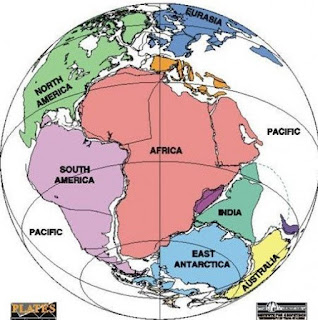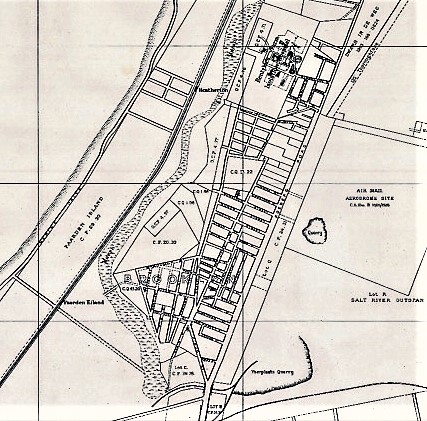Milnerton's Twin
Did you know that long before we or any other humans set foot in Milnerton, it was connected to the east coast of what is now Argentina?
About 335 million years ago, during the late Paleozoic and early Mesozoic eras, the continents as we know them today were still part of a super-continent known as Pangaea, the name being derived from the Ancient Greek pan ('all, entire, whole') and Gaia ('Mother Earth, land').
Then, about 175 million years ago, shifts in the earth's tectonic plates caused Pangaea to break apart. It was during the second of the three phases of this process, in the Middle Cretaceous period, that South America started to move westwards away from Africa and the South Atlantic Ocean opened up.
The area now known as the Cape Peninsula broke away from the area now known as San Matias Gulf in Argentina. What is now Milnerton was once connected to what is now Bahia Blanca, a city lying to the south of Buenos Aires, where the Naposta Stream flows into the South Atlantic. Bahia Blanca means 'White Bay', its name deriving from the white salt covering the soil near the shore. It is significant that for many years there were salt pans in Milnerton, where the Diep River now flows into Rietvlei and then out into the South Atlantic.
Evidence of this ancient connection is also found in matching geological features between South Africa's west coast and South America's east coast. For example, geologists have established that the Cape Fold Belt, which is of late Paleozoic age, was originally continuous with the Ventana Mountains near Bahia Blanca in Argentina.
There is also fossil evidence of the connection, with fossils of the freshwater reptile Mesosaurus having been found only in localised regions of the coasts of South America and South Africa - and nowhere else in the world.
One result of the shifting of tectonic plates is the Milnerton Fault, a fissure within the earth's crust, which starts about 8 kilometres off-shore to the north of Table Bay and runs in a south-easterly direction through Milnerton and out across the Cape Flats.
Seismic shifts along this fault line have caused earthquakes, some of which have occurred within recorded history: in 1620, 1695, 1809, 1811, 1969, 2004 and 2009. The most serious of these earthquakes occurred on the evening of 4 December 1809, causing extensive damage on the farm Jan Biesjes Kraal. The farmhouse was situated on what is now Milnerton Ridge, overlooking Rietvlei, where scientists think that the fault comes ashore.
When the naturalist Baron Wilhelm von Buchenroder visited the area five days later, he found rents and fissures in the ground, one of which was more than a mile long. Chatting to the locals, he received reports that some of the fissures had opened to about 4 inches wide and in excess of 10 feet deep.
Chris Hartnady, an international expert on geotectonics and technical director of the Umvoto science consultancy, wrote on the company's website that he estimated the size of the 1809 quake to be 6,5 on the Richter scale. The website states: 'Earthquakes are a rare but a very real threat for Cape Town... increased public awareness of this hazard is needed.' One major concern is that the Koeberg Nuclear Power Station is situated very close to the fault line.
The Eskom spokesperson on nuclear matters, Tony Scott, says that the Koeberg plant has been designed to withstand an earthquake of 7,0 on the Richter scale, '... as if the epicentre of the earthquake were right under Koeberg, although the Milnerton fault line is 8 to 9 kilometres away.' Before construction began, Eskom dug through the surface sand to get to solid bedrock. They then laid a 6-metre foundation of cement, on which they placed pillars with neoprone rubbers on top to absorb vertical movement. Above that, they put a metal plate, which is designed to allow sideways movement. Koeberg was built on top of this plate.
So... nothing to worry about at all, then. I'm not so sure. Perhaps it would have been preferable had the Cape Peninsula split off along the fault line and remained part of Argentina.
"Buen dia!"
If you've enjoyed reading this blog, you'll be pleased to know that I'll be writing a new blog on aspects of Milnerton's history every week. These will alternate between personal reminiscences and straight historical articles. Please keep a record of the site: milnertonian.blogspot.com
About 335 million years ago, during the late Paleozoic and early Mesozoic eras, the continents as we know them today were still part of a super-continent known as Pangaea, the name being derived from the Ancient Greek pan ('all, entire, whole') and Gaia ('Mother Earth, land').
Then, about 175 million years ago, shifts in the earth's tectonic plates caused Pangaea to break apart. It was during the second of the three phases of this process, in the Middle Cretaceous period, that South America started to move westwards away from Africa and the South Atlantic Ocean opened up.
The area now known as the Cape Peninsula broke away from the area now known as San Matias Gulf in Argentina. What is now Milnerton was once connected to what is now Bahia Blanca, a city lying to the south of Buenos Aires, where the Naposta Stream flows into the South Atlantic. Bahia Blanca means 'White Bay', its name deriving from the white salt covering the soil near the shore. It is significant that for many years there were salt pans in Milnerton, where the Diep River now flows into Rietvlei and then out into the South Atlantic.
Evidence of this ancient connection is also found in matching geological features between South Africa's west coast and South America's east coast. For example, geologists have established that the Cape Fold Belt, which is of late Paleozoic age, was originally continuous with the Ventana Mountains near Bahia Blanca in Argentina.
There is also fossil evidence of the connection, with fossils of the freshwater reptile Mesosaurus having been found only in localised regions of the coasts of South America and South Africa - and nowhere else in the world.
One result of the shifting of tectonic plates is the Milnerton Fault, a fissure within the earth's crust, which starts about 8 kilometres off-shore to the north of Table Bay and runs in a south-easterly direction through Milnerton and out across the Cape Flats.
Seismic shifts along this fault line have caused earthquakes, some of which have occurred within recorded history: in 1620, 1695, 1809, 1811, 1969, 2004 and 2009. The most serious of these earthquakes occurred on the evening of 4 December 1809, causing extensive damage on the farm Jan Biesjes Kraal. The farmhouse was situated on what is now Milnerton Ridge, overlooking Rietvlei, where scientists think that the fault comes ashore.
When the naturalist Baron Wilhelm von Buchenroder visited the area five days later, he found rents and fissures in the ground, one of which was more than a mile long. Chatting to the locals, he received reports that some of the fissures had opened to about 4 inches wide and in excess of 10 feet deep.
Chris Hartnady, an international expert on geotectonics and technical director of the Umvoto science consultancy, wrote on the company's website that he estimated the size of the 1809 quake to be 6,5 on the Richter scale. The website states: 'Earthquakes are a rare but a very real threat for Cape Town... increased public awareness of this hazard is needed.' One major concern is that the Koeberg Nuclear Power Station is situated very close to the fault line.
The Eskom spokesperson on nuclear matters, Tony Scott, says that the Koeberg plant has been designed to withstand an earthquake of 7,0 on the Richter scale, '... as if the epicentre of the earthquake were right under Koeberg, although the Milnerton fault line is 8 to 9 kilometres away.' Before construction began, Eskom dug through the surface sand to get to solid bedrock. They then laid a 6-metre foundation of cement, on which they placed pillars with neoprone rubbers on top to absorb vertical movement. Above that, they put a metal plate, which is designed to allow sideways movement. Koeberg was built on top of this plate.
So... nothing to worry about at all, then. I'm not so sure. Perhaps it would have been preferable had the Cape Peninsula split off along the fault line and remained part of Argentina.
"Buen dia!"
If you've enjoyed reading this blog, you'll be pleased to know that I'll be writing a new blog on aspects of Milnerton's history every week. These will alternate between personal reminiscences and straight historical articles. Please keep a record of the site: milnertonian.blogspot.com






Comments
Post a Comment